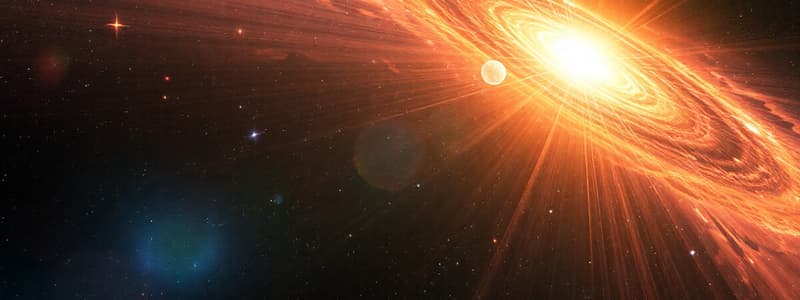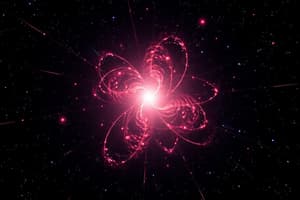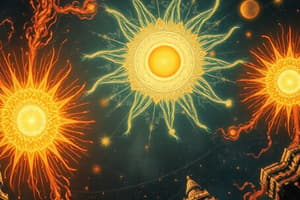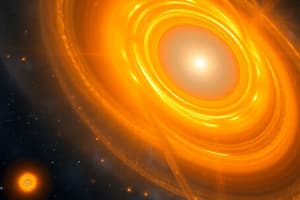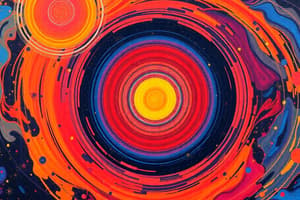Podcast
Questions and Answers
Jocelyn Bell Burnell's initial interpretation of the regular radio waves she detected involved a playful assumption before conclusive identification. Which of the following best captures the core reason behind this initial assumption?
Jocelyn Bell Burnell's initial interpretation of the regular radio waves she detected involved a playful assumption before conclusive identification. Which of the following best captures the core reason behind this initial assumption?
- The signals' unusual precision and regularity contrasted with known natural phenomena, suggesting an artificial origin. (correct)
- Her supervisor, Antony Hewish, suggested the possibility of an artificial origin as a thought experiment.
- Contemporary theories predicted the existence of extraterrestrial life, making it a logical first consideration.
- The limitations of the radio telescope technology at the time made it difficult to distinguish between natural and artificial signals.
Considering the context of Jocelyn Bell Burnell's discovery of pulsars, what was the most significant impact of this discovery on the field of astrophysics?
Considering the context of Jocelyn Bell Burnell's discovery of pulsars, what was the most significant impact of this discovery on the field of astrophysics?
- It introduced a new method for detecting quasars, leading to a more precise mapping of the universe.
- It validated the theoretical existence of neutron stars, which had previously been unconfirmed. (correct)
- It disproved the established theories about cosmic radiation, paving the way for new theoretical models.
- It resolved the debate about the origin of fast radio bursts, confirming their galactic source.
Despite Jocelyn Bell Burnell's pivotal role in the discovery of pulsars, the Nobel Prize in Physics was awarded to her supervisor, Antony Hewish. Which of the following statements most accurately reflects the challenges this situation highlights within the scientific community?
Despite Jocelyn Bell Burnell's pivotal role in the discovery of pulsars, the Nobel Prize in Physics was awarded to her supervisor, Antony Hewish. Which of the following statements most accurately reflects the challenges this situation highlights within the scientific community?
- The inherent difficulty in assigning credit for collaborative discoveries in astrophysics.
- The Nobel Prize committee's historical tendency to favor theoretical over empirical discoveries.
- The lack of established protocols for recognizing junior researchers' contributions in major scientific breakthroughs.
- The under-recognition of women's contributions in scientific research due to prevailing gender biases. (correct)
Jocelyn Bell Burnell's work involved both the construction of radio telescopes and the analysis of the data they produced. How did these dual roles contribute to her groundbreaking discovery of pulsars?
Jocelyn Bell Burnell's work involved both the construction of radio telescopes and the analysis of the data they produced. How did these dual roles contribute to her groundbreaking discovery of pulsars?
How did the initial discovery and subsequent confirmation of pulsars challenge existing scientific theories regarding the nature of celestial objects and their emissions?
How did the initial discovery and subsequent confirmation of pulsars challenge existing scientific theories regarding the nature of celestial objects and their emissions?
Flashcards
Pulsar
Pulsar
A rapidly rotating, strongly magnetized neutron star that emits pulses of radiation.
Jocelyn Bell Burnell's Discovery
Jocelyn Bell Burnell's Discovery
Jocelyn Bell Burnell was the first to detect pulsars.
LGM-1
LGM-1
Radio waves pulsing in space with suspicious precision, initially considered possibly artificial.
Quasars
Quasars
Signup and view all the flashcards
Antony Hewish
Antony Hewish
Signup and view all the flashcards
Study Notes
- Jocelyn Bell Burnell was the first scientist to detect pulsars as a young postgraduate student.
- She opened up a new branch of astrophysics.
- Born in Belfast, Northern Ireland.
- She developed a flair for science at boarding school.
- After graduating from Glasgow University in 1965, she began a PhD thesis on twinkling quasars at Cambridge University.
- Under the supervision of Antony Hewish, she helped design and build an array of radio telescopes to detect quasars.
- Quasars are a recently discovered form of high-energy cosmic radiation.
- In November 1967, instruments detected unexpected signals.
- The signals were radio waves pulsating every 1.337 seconds, coming from a fixed point in space.
- Similar signals were detected in other parts of space over the following two months.
- She and Hewish concluded that the radio waves came from the radiation beam of a rapidly rotating, strongly magnetized neutron star.
- Each rotation emitted a "pulse," giving the name "pulsar" to this new class of star.
- Bell Burnell playfully applied the working title LGM-1 (Little Green Men-1) to the suspiciously precise radio waves.
- The term "pulsar" was coined in 1968.
Milestones
- 1967: A pulsar observed.
- Antony Hewish reported on the discovery in a Nature article the following year.
- Physics Prize: Although she was not named in the award herself, her supervisor received the Nobel Prize in 1974.
- Official Recognition: Made a Dame Commander of the British Empire (DBE) in 2007 for services to astronomy.
Studying That Suits You
Use AI to generate personalized quizzes and flashcards to suit your learning preferences.
Description
Jocelyn Bell Burnell, as a postgraduate student, first detected pulsars, opening a new branch of astrophysics. While working on her PhD thesis at Cambridge University, instruments detected unexpected signals. These signals turned out to be radio waves pulsating from a fixed point in space proving the existence of rapidly rotating, strongly magnetized neutron star.
